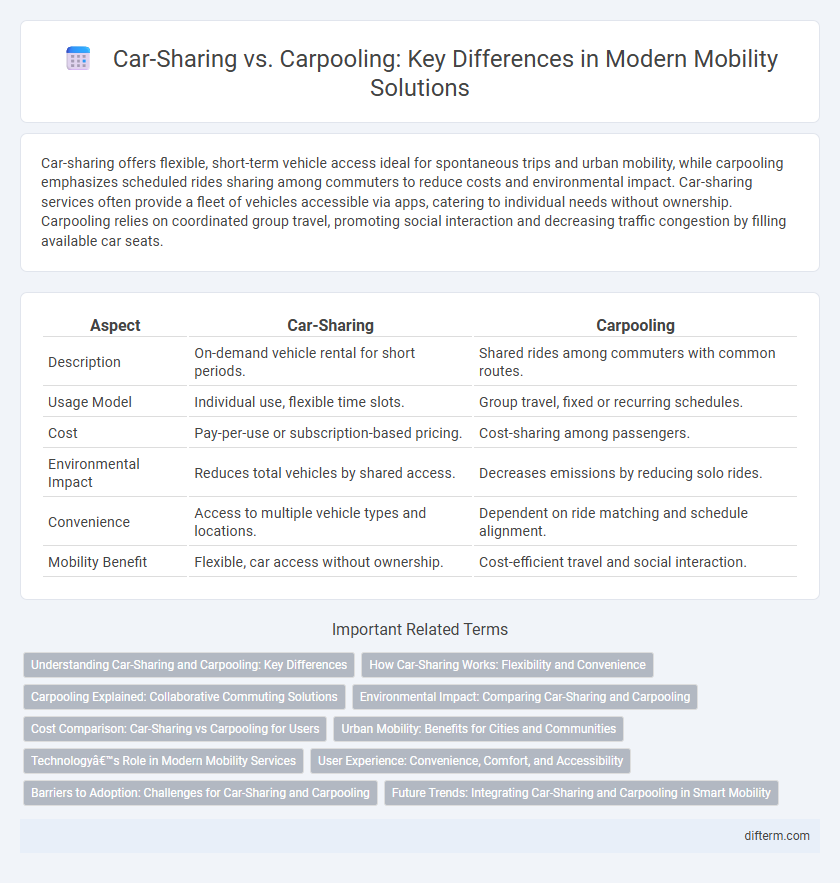Car-sharing offers flexible, short-term vehicle access ideal for spontaneous trips and urban mobility, while carpooling emphasizes scheduled rides sharing among commuters to reduce costs and environmental impact. Car-sharing services often provide a fleet of vehicles accessible via apps, catering to individual needs without ownership. Carpooling relies on coordinated group travel, promoting social interaction and decreasing traffic congestion by filling available car seats.
Table of Comparison
| Aspect | Car-Sharing | Carpooling |
|---|---|---|
| Description | On-demand vehicle rental for short periods. | Shared rides among commuters with common routes. |
| Usage Model | Individual use, flexible time slots. | Group travel, fixed or recurring schedules. |
| Cost | Pay-per-use or subscription-based pricing. | Cost-sharing among passengers. |
| Environmental Impact | Reduces total vehicles by shared access. | Decreases emissions by reducing solo rides. |
| Convenience | Access to multiple vehicle types and locations. | Dependent on ride matching and schedule alignment. |
| Mobility Benefit | Flexible, car access without ownership. | Cost-efficient travel and social interaction. |
Understanding Car-Sharing and Carpooling: Key Differences
Car-sharing involves short-term access to a shared vehicle fleet typically managed by a company, allowing users to rent cars by the hour or day, while carpooling requires multiple passengers to share a single vehicle for commuting or specific trips. Car-sharing offers flexibility and convenience through app-based booking and autonomous vehicle dispatch, reducing private car ownership and parking demand. Carpooling emphasizes cost savings and environmental benefits by maximizing vehicle occupancy and decreasing traffic congestion during peak hours.
How Car-Sharing Works: Flexibility and Convenience
Car-sharing offers users on-demand access to vehicles parked nearby, allowing short-term rentals by the hour or minute through easy-to-use mobile apps. This flexible model eliminates the need for ownership, providing convenient access without long-term commitments or insurance responsibilities. Unlike carpooling, which depends on coordinating group travel, car-sharing operates independently, granting greater spontaneity and personalized travel options.
Carpooling Explained: Collaborative Commuting Solutions
Carpooling enables multiple commuters to share a single vehicle, reducing traffic congestion, lowering carbon emissions, and cutting individual transportation costs. Unlike car-sharing, which allows users to rent vehicles on-demand, carpooling fosters regular collaboration among passengers with similar routes or schedules. Effective carpooling relies on coordinated scheduling apps, designated pick-up points, and incentives from employers or local governments to maximize participation and environmental benefits.
Environmental Impact: Comparing Car-Sharing and Carpooling
Car-sharing reduces the number of privately owned vehicles on the road, significantly lowering carbon emissions by optimizing vehicle usage and promoting electric or hybrid fleet options. Carpooling minimizes environmental impact by decreasing the total number of trips made, cutting fuel consumption and greenhouse gas emissions per passenger. Both models contribute to sustainable urban mobility, with car-sharing emphasizing resource efficiency and carpooling focusing on collective ride utilization.
Cost Comparison: Car-Sharing vs Carpooling for Users
Car-sharing typically involves higher hourly or mileage fees compared to carpooling, where costs are split among passengers, significantly lowering individual expenses. Users of carpooling save on parking and fuel by sharing trips with others, making it a cost-effective option for regular commutes. While car-sharing offers flexibility without dependency on others, carpooling remains the most budget-friendly choice for reducing transportation costs.
Urban Mobility: Benefits for Cities and Communities
Car-sharing reduces the number of privately owned vehicles, alleviating urban congestion and decreasing parking demand, which enhances street accessibility for pedestrians and cyclists. Carpooling optimizes vehicle occupancy, lowering emissions per passenger and cutting overall traffic volume, contributing to improved air quality and reduced noise pollution in densely populated areas. Both models promote sustainable urban mobility by fostering shared resource use, decreasing carbon footprints, and supporting community connectivity within cities.
Technology’s Role in Modern Mobility Services
Advanced mobile apps and GPS technologies drive the evolution of car-sharing and carpooling by improving route optimization and real-time vehicle availability. AI-powered algorithms enhance user matching and demand prediction, reducing wait times and increasing fleet efficiency. Integration with smart city infrastructure enables seamless payment systems and dynamic pricing, making modern mobility services more accessible and environmentally sustainable.
User Experience: Convenience, Comfort, and Accessibility
Car-sharing offers users flexible access to vehicles on demand, enhancing convenience by eliminating the need for vehicle ownership and reducing wait times through app-based reservations. In contrast, carpooling often requires coordinating schedules with multiple riders, which can impact comfort and accessibility due to varying pick-up locations and shared travel routes. Both models improve urban mobility, but car-sharing excels in providing personalized comfort and immediate availability, while carpooling emphasizes cost-efficiency and social interaction.
Barriers to Adoption: Challenges for Car-Sharing and Carpooling
Barriers to adoption for car-sharing include limited vehicle availability, concerns over hygiene, and perceived higher costs compared to personal car ownership. Carpooling faces challenges such as coordinating schedules, lack of trust among participants, and privacy concerns during shared rides. Both mobility solutions struggle with inadequate infrastructure support and resistance to changing traditional travel habits.
Future Trends: Integrating Car-Sharing and Carpooling in Smart Mobility
Future trends in smart mobility emphasize the integration of car-sharing and carpooling platforms to optimize urban transportation efficiency and reduce carbon emissions. Advanced data analytics and AI-driven algorithms enable real-time matching of users with available vehicles and shared rides, enhancing convenience and accessibility. This convergence supports sustainable mobility goals by minimizing individual car ownership and maximizing vehicle utilization across metropolitan areas.
car-sharing vs carpooling Infographic

 difterm.com
difterm.com